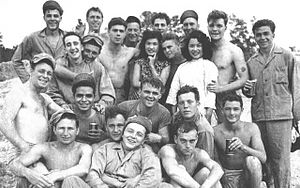This article has multiple issues. Please help improve it or discuss these issues on the talk page. (Learn how and when to remove these messages)
|
| Operation Beleaguer | |||||||
|---|---|---|---|---|---|---|---|
| Part of the Chinese Civil War and the Cold War | |||||||
 Marines in Qingdao during Operation Beleaguer | |||||||
| |||||||
| Belligerents | |||||||
|
|
| ||||||
| Commanders and leaders | |||||||
|
Albert C. Wedemeyer Alvan C. Gillem, Jr. Keller E. Rockey Dewitt Peck Samuel L. Howard Omar T. Pfeiffer Thomas C. Kinkaid |
Mao Zedong Zhou Enlai | ||||||
| Units involved | |||||||
|
III Amphibious Corps Task Force 78 14th Air Force 33rd Special and 96th U.S. Naval Construction Battalions UDT 9 | 8th Route Army | ||||||
| Strength | |||||||
| 50,000[1][2] | Unknown | ||||||
| Casualties and losses | |||||||
|
35 killed 43 wounded[3] |
47 killed 12 captured | ||||||
Operation Beleaguer[4] was the codename for the United States Marine Corps' occupation of northeastern China's Hebei and Shandong provinces from 1945 until 1949. The Marines were tasked with overseeing the repatriation of more than 600,000 Japanese and Koreans that remained in China at the end of World War II. During the four-year occupation, American forces engaged in several skirmishes with the People's Liberation Army while successfully evacuating thousands of foreign nationals. The United States Government attempted to mediate a peace treaty between the opposing Nationalist and Communist factions but was unsuccessful. The Marines departed Northern China in June 1949 a few months before the communists won the Chinese Civil War and took control of mainland China.[1][5][6]
- ^ a b "The United States Marines in North China, 1945-1949". Archived from the original on March 22, 2013. Retrieved April 6, 2013.
- ^ "When World War II really ended: The Antrim Review: Local News". Archived from the original on July 3, 2013. Retrieved April 6, 2013.
- ^ Millett, Allan R. (1991). Semper fidelis: the history of the United States Marine Corps. Simon and Schuster. ISBN 002921596X.
- ^ "Operation BELEAGUER: The Marine III Amphibious Corps in North China, 1945-1949: Marine Corps Gazette". Archived from the original on March 12, 2013. Retrieved April 6, 2013.
- ^ "af.mil". Archived from the original on February 13, 2013. Retrieved April 6, 2013.